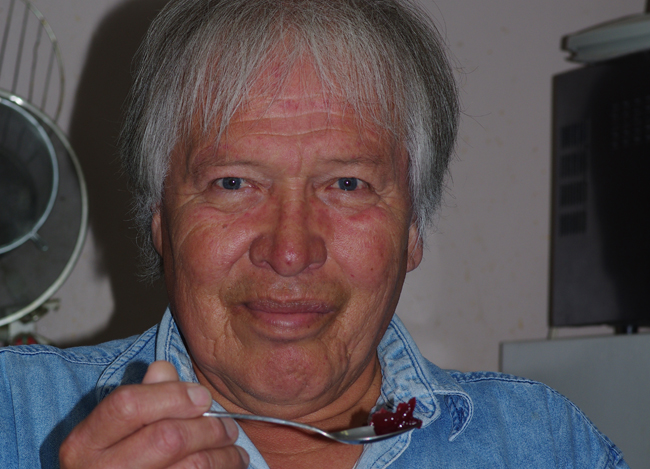Cranberry harvest full of tradition and goodness

By Rick Garrick
ATIKAMEKSHENG ANISHNAWBEK – Traditional artisan Ken Wabegijig enjoys harvesting –and eating – wild cranberries from a bog near his mother’s home community of Whitefish Lake.
“I’ve been picking cranberries since I was a little kid — that’s something we’ve always done throughout the years,” says the Thunder Bay resident. “My grandfather, my grandmother and everybody in the family has always been picking cranberries in the fall.”
Wabegijig recalls paddling in a canoe with his father, originally from Wikwemikong, when he was older to reach the cranberry bog.
“Then we found another way in,” Wabegijig says. “A beaver built this dam. We walk across that little dam now, it takes us right into the marsh. It just makes things so much easier.”
While other Anishinabe families used to harvest the cranberries along with Wabegijig’s family in the past, he says they gradually stopped taking part in the harvest.
“They used to go with burlap bags and fill them up and sell them,” Wabegijig says. “But over the years it’s come to the point where nobody does that anymore, nobody buys them at all.”
Wabegijig travelled down to Whitefish Lake in September for the cranberry harvest, where he picked about 12 litres of cranberries, after his brother informed him there was a bumper crop this year.
“He said the last couple of years the bears have been eating the cranberries because there were no berries for them,” Wabegijig says. “We went into the marsh and it was a bumper crop. I got my year’s supply that I need.”
Wabegijig always leaves a tobacco offering whenever he travels to the cranberry bog.
“I’m very respectful of it, because to me it is like a medicine,” Wabegijig says. “It helps me; it flushes my system. It’s good for the urinary system.”
Wabegijig usually stores his unripened cranberries in a paper bag in a cool, dark place until they ripen.
“Over time, the berries will get riper and riper and riper,” Wabegijig says. “When they’re really ripe, they’re freezable. Or I can make a sauce and put it in a jar.”
Wabegijig usually adds sugar, apple, lemon, orange juice and sometimes lemon or orange zest to his cranberries when cooking cranberry sauce.
“But they’re good raw, if you can get used to them,” Wabegijig says. “(They’re) a little bit sour, a little bit tart, but they’re nice and crunchy and they have a nice snap to them.”
Wabegijig feels secure about the future of the cranberry bog, noting his 25-year-old niece has been taking a special interest in the harvest.
“We’ve taken our niece in with us a couple of times — she’s very enthusiastic about it.”


